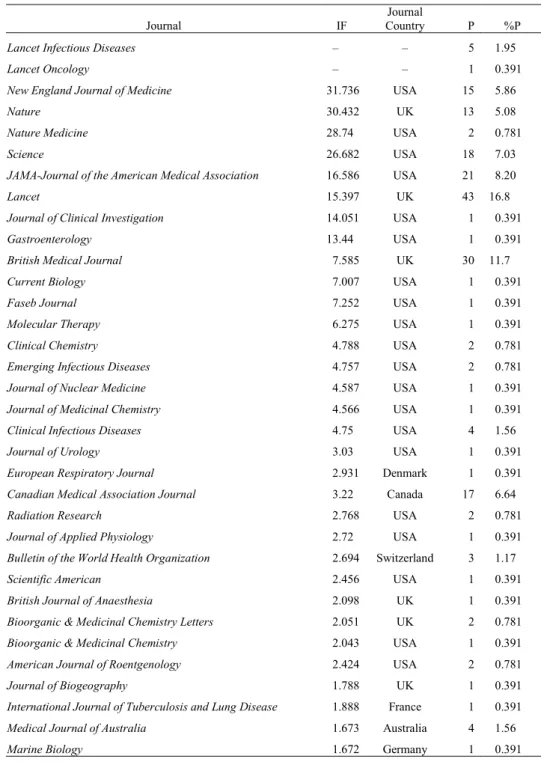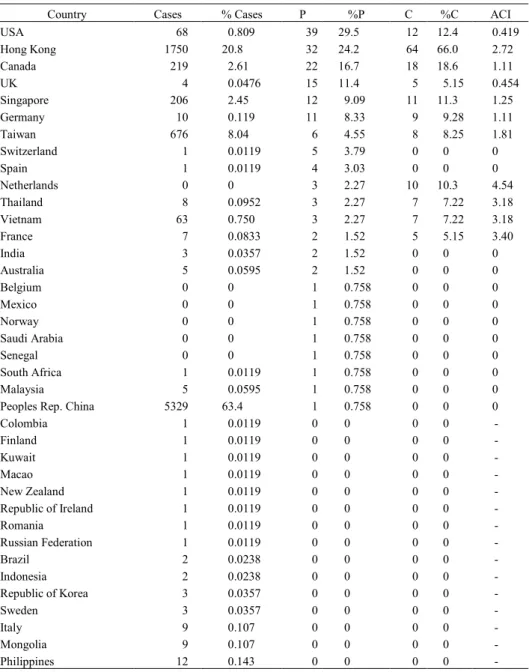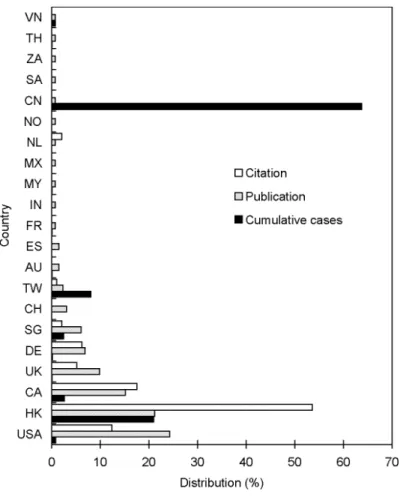Received March 30, 2004 Address for correspondence: YUH-SHAN HO
Bibliometric Centre, Taipei Medical University – Wan-Fang Hospital 111 Hsing-Long Road Sec. 3, Taipei 116, Taiwan
Bibliometric analysis of Severe Acute Respiratory
Syndrome-related research in the beginning stage
WEN-TA CHIU,a JING-SHAN HUANG,b YUH-SHAN HOa,c a Taipei Medical University – Wan-Fang Hospital, Taipei (Taiwan)
b Cathay General Hospital, Taipei (Taiwan)
c School of Public Health, Taipei Medical University, Taipei (Taiwan)
Severe Acute Respiratory Syndrome (SARS) has become the major of health issues since its outbreak early 2003. No analyses by bibliometric technique that have examined this topic exist in the literature. The objective of this study is to conduct a bibliometric analysis of all SARS-related publications inScience Citation Index (SCI) in the early stage. A systematic search was performed using the SCI for publications since SARS outbreak early 2003. Selected documents included ‘severe acute respiratory syndrome’ or ‘SARS’ as a part of its title, abstract, or keyword from the beginning stage of SARS outbreak, March till July 8, 2003. Analysis parameters included authorship, patterns of international collaboration, journals, language, document type, research institutional address, times cited, and reprint address. Citation analysis was mainly based on impact factor as defined by Journal Citation Reports (JCR) issued in 2002 and on the actual citation impact (ACI), which has been used to assess the impact relative to the whole field and has been defined as the ratio between individual citation per publication value and the total citation per publication value. Thirty-two percent of total share was published as news features, 25% as editorial materials, 22% as articles, 13% as letters, and the remaining being biographic items, corrections, meeting abstracts, and reprints. The US dominated the production by 30% of the total share followed closely by Hong Kong with 24%. Sixty-three percent of publication was published by the mainstream countries. The SARS publication pattern in the past few months suggests immediate citation, low collaboration rate, and English and mainstream country domination in production. We observed no associations of research indexes with the number of cases.
Introduction
Infectious diseases have always been a threat to humans, especially when social conditions were continuously changing. Well-known epidemics such as the bubonic plague, AIDS, the Ebola virus in the 1980s, the influenza pandemic of 1918, and presently, the Severe Acute Respiratory Syndrome (SARS) has seriously affected us.1 SARS was first identified in February 2003 by an Italian expert, Carlo Urbani and his early work to detect SARS has heightened the global surveillance level and made many
new cases identified.2 SARS broke out rapidly and seriously affected life in Hong Kong, Singapore, Toronto, Taiwan, and various regions of China since early March 2003. From November 1st 2002 to June 6th 2003, there were 8,404 SARS cases with 779 deaths and with 5,937 being recovered.3 The technique to sequence SARS virus was completed in mid April 2003 to make future development of drugs and vaccines possible.
The defensive move the human will take against this disease can only be established among scientists with sufficient communications. The most common mean is through publication.4 Garfield in 1970 also observed that a recent research focus can be reflected on its publication output.5 Hence, a dramatic increase of SARS-related publications would be expected shortly after the outbreak. This study was intended to analyze significant SARS publication patterns, especially in international collaboration and authors’ country of origin in the beginning stage of SARS outbreak.
Materials and methods
Publications used in this analysis were extracted from the Science Citation Index (SCI) established by the Institute of Scientific Information (ISI), in Philadelphia, the United States. Selected documents included ‘severe acute respiratory syndrome’ or ‘SARS’ as a part of its title, abstract, or keyword from March till the update of July 8, 2003. Then, we checked the search result to make sure that all entries were related to the SARS topic. Analysis parameters include authorship, patterns of international collaboration, journals, language, document type, research institutional address, times cited, and reprint address. Citation analysis was partly based on Journal Impact Factors, as defined by Journal Citation Report (JCR) for the journals actually published the SARS articles (Table 1) partly on the number of citations received per publication during the period studied in 2003, and relative to the average citation impact of the SARS publications covering the same period (Table 2). The average citation impact, corresponding to a kind of Immediacy Index for SARS, 2003, was 0.735 citations per published article with research institutional address (97 cit./132 publ.), January-July, 2003.
Results and discussion
Six papers were published in March, 45 in April, 132 in May, 68 in June and 2 in July as of July 8th. Total production was 256 papers by 38 countries with 48% being absent in recorded address. Thirty-two percent of total share was published as news features, 25% as editorial materials, 22% as articles, 13% as letters, and the remaining being biographic items, corrections, meeting abstracts, and reprints.
Table 1. Publication, impact factor, and country distribution of journals
Journal IF
Journal
Country P %P
Lancet Infectious Diseases – – 5 1.95
Lancet Oncology – – 1 0.391
New England Journal of Medicine 31.736 USA 15 5.86
Nature 30.432 UK 13 5.08
Nature Medicine 28.74 USA 2 0.781
Science 26.682 USA 18 7.03
JAMA-Journal of the American Medical Association 16.586 USA 21 8.20
Lancet 15.397 UK 43 16.8
Journal of Clinical Investigation 14.051 USA 1 0.391
Gastroenterology 13.44 USA 1 0.391
British Medical Journal 7.585 UK 30 11.7
Current Biology 7.007 USA 1 0.391
Faseb Journal 7.252 USA 1 0.391
Molecular Therapy 6.275 USA 1 0.391
Clinical Chemistry 4.788 USA 2 0.781
Emerging Infectious Diseases 4.757 USA 2 0.781
Journal of Nuclear Medicine 4.587 USA 1 0.391
Journal of Medicinal Chemistry 4.566 USA 1 0.391
Clinical Infectious Diseases 4.75 USA 4 1.56
Journal of Urology 3.03 USA 1 0.391
European Respiratory Journal 2.931 Denmark 1 0.391
Canadian Medical Association Journal 3.22 Canada 17 6.64
Radiation Research 2.768 USA 2 0.781
Journal of Applied Physiology 2.72 USA 1 0.391
Bulletin of the World Health Organization 2.694 Switzerland 3 1.17
Scientific American 2.456 USA 1 0.391
British Journal of Anaesthesia 2.098 UK 1 0.391
Bioorganic & Medicinal Chemistry Letters 2.051 UK 2 0.781
Bioorganic & Medicinal Chemistry 2.043 USA 1 0.391
American Journal of Roentgenology 2.424 USA 2 0.781
Journal of Biogeography 1.788 UK 1 0.391
International Journal of Tuberculosis and Lung Disease 1.888 France 1 0.391
Medical Journal of Australia 1.673 Australia 4 1.56
Table 1. continued
Journal IF
Journal
Country P %P
Journal of the American Statistical Association 1.669 USA 1 0.391
British Journal of General Practice 1.593 UK 3 1.17
Journal of the American Veterinary Medical Association 1.25 USA 1 0.391
Clinical Radiology 1.048 UK 1 0.391
Medicina Clinica 0.854 Spain 2 0.781
Cleveland Clinic Journal of Medicine 0.722 USA 1 0.391
Journal of Crustacean Biology 0.724 USA 1 0.391
Journal of Small Animal Practice 0.704 UK 1 0.391
International Journal of Surgical Pathology 0.663 USA 1 0.391 Deutsche Medizinische Wochenschrift 0.651 Germany 3 1.17
Journal of Biosciences 0.606 India 1 0.391
Chinese Science Bulletin 0.57 Peoples R China 1 0.391
Chemical & Engineering News 0.465 USA 6 2.34
Chemistry & Industry 0.461 UK 3 1.17
New Scientist 0.277 USA 6 2.34
Organisms Diversity & Evolution 0.45 Germany 1 0.391
Infections in Medicine 0.298 USA 1 0.391
Physician and Sportsmedicine 0.492 USA 1 0.391
Presse Medicale 0.395 France 1 0.391
Scientist 0.365 USA 1 0.391
Saudi Medical Journal 0.301 Saudi Arabia 1 0.391
Laboratory Medicine 0.259 USA 1 0.391
American Journal of Nursing 0.242 USA 3 1.17
Geriatric Nursing 0.168 USA 1 0.391
Natural History 0.157 USA 1 0.391
Genetic Engineering News 0.114 USA 3 1.17
Aviation Week & Space Technology 0.023 USA 4 1.56
Professional Engineering 0.04 UK 1 0.391
Veterinary Economics 0.025 USA 1 0.391
E&MJ-Engineering and Mining Journal 0.011 USA 1 0.391 IF: Impact factor, P: Publication, %P: Percentage of publication
Table 2. Publication, citation, and case number distribution among origin of countries
Country Cases % Cases P %P C %C ACI
USA 68 0.809 39 29.5 12 12.4 0.419 Hong Kong 1750 20.8 32 24.2 64 66.0 2.72 Canada 219 2.61 22 16.7 18 18.6 1.11 UK 4 0.0476 15 11.4 5 5.15 0.454 Singapore 206 2.45 12 9.09 11 11.3 1.25 Germany 10 0.119 11 8.33 9 9.28 1.11 Taiwan 676 8.04 6 4.55 8 8.25 1.81 Switzerland 1 0.0119 5 3.79 0 0 0 Spain 1 0.0119 4 3.03 0 0 0 Netherlands 0 0 3 2.27 10 10.3 4.54 Thailand 8 0.0952 3 2.27 7 7.22 3.18 Vietnam 63 0.750 3 2.27 7 7.22 3.18 France 7 0.0833 2 1.52 5 5.15 3.40 India 3 0.0357 2 1.52 0 0 0 Australia 5 0.0595 2 1.52 0 0 0 Belgium 0 0 1 0.758 0 0 0 Mexico 0 0 1 0.758 0 0 0 Norway 0 0 1 0.758 0 0 0 Saudi Arabia 0 0 1 0.758 0 0 0 Senegal 0 0 1 0.758 0 0 0 South Africa 1 0.0119 1 0.758 0 0 0 Malaysia 5 0.0595 1 0.758 0 0 0
Peoples Rep. China 5329 63.4 1 0.758 0 0 0
Colombia 1 0.0119 0 0 0 0 -Finland 1 0.0119 0 0 0 0 -Kuwait 1 0.0119 0 0 0 0 -Macao 1 0.0119 0 0 0 0 -New Zealand 1 0.0119 0 0 0 0 -Republic of Ireland 1 0.0119 0 0 0 0 -Romania 1 0.0119 0 0 0 0 -Russian Federation 1 0.0119 0 0 0 0 -Brazil 2 0.0238 0 0 0 0 -Indonesia 2 0.0238 0 0 0 0 -Republic of Korea 3 0.0357 0 0 0 0 -Sweden 3 0.0357 0 0 0 0 -Italy 9 0.107 0 0 0 0 -Mongolia 9 0.107 0 0 0 0 -Philippines 12 0.143 0 0 0 0
-Cases: Cumulative number of cases from 1 Nov 2002 to 6 June 2003 WHO Report (http://www.who.int/csr/sars/country/2003_06_06/en/)
%Cases: percentage of cumulative number of cases, P: publications, %P: percentage of publications, C: citations, %C: percentage of citations, ACI: actual citation impact
Similar to the finding of a study on drug and alcohol journals,6 the quantity of SARS-related articles were found to be low. That a high percentage share of news item was found might be a faster way of communication. As shown in Table 1, 256 documents were published in 64 SCI journals, with 61% Northern American journals, 20% in European journals, 5% in Asian journals and 3% with no records in JCR of 2002. Four journals had impact factors higher than 20, 4 journals impact factors between 10 and 20, 4 between 5 and 10, 24 between 1 and 5, and 26 below 1. Fifty-seven percent of the documents was published in journals with impact factors higher than 5. The US dominated the journal countries followed distantly by the UK. Four languages were used for all SCI publications. Ninety-eight percent of total journals was published in English. Only 3 journals published in German, 2 in Spanish, and 1 in French.
In analyzing 132 documents with recorded addresses. We found that the US dominated the production by 30% of total share followed closely by Hong Kong with 24%. Out of 38 document-producing countries, Belgium, Mexico, the Netherlands, Norway, Saudi Arabia, and Senegal did not report any SARS cases (Table 2). Out of 32 countries with SARS cases, 47% of them had no SCI publications. Surprisingly, China with most cases had only one SCI publication. Moreover, 24% of documents was published by Hong Kong where 1,750 cases have been reported. Sixty-three percent of publication was published by the mainstream countries such as the US, the UK, Canada, Germany, and Switzerland where only 302 cases have been reported totally.
Domination in publication was not surprising from mainstream countries since this pattern has occurred in most scientific fields.7,8 High production in countries with many cases would be due to active research of the disease, mainly on identification, diagnosis, and treatment. Contra wise mainstream countries would focus on controlling the disease and developing possible drugs and vaccines. The number of SARS cases did not affect the SCI publication output. However, countries with SARS cases, especially China, may have published in non-SCI journals that were not included in this study. All documents in this study were published in English. Thus, scientists in non-English speaking countries may have disadvantages in publishing in SCI journals since English is lingua franca of science.9,10 In a short period of time, English may not be the choice of communication language for those scientists who are not native speakers. Publishing was from Europe and Asia besides two Northern American countries. In our study, we found that only 17% of SARS-related papers were internationally collaborated. This finding is unusual since international collaboration is essential in modern science.11
Although citation by other authors was affected significantly by visibility,12 the citation frequency of SARS-related articles was considered to be high. Papers published from 11 countries had been cited in the short period after its appearance in print published. The country with the highest ACI value of 4.54 was the Netherlands. Except the US and the UK, all other countries have ACI higher than 1. The finding that low ACI values of these two countries was surprising because that both they had not had
many reported SARS cases. In the ACI ranking, number of SARS cases has affected citation pattern. Hong Kong, where had the serious SARS outbreak and the sequencing of corona virus been completed, has the most impact to this field. Further analysis show that there is no evidence of association between number of national SARS cases and article production (Pearson r = 0.130, p value = 0.437), national citations received (Pearson r = 0.248, p value = 0.134), and national citation impact (Pearson r = -0.046, p value = 0.835)
.
Figure 1. SARS cases, citation and publication distribution of reprint address
VN: Vietnam, TH: Thailand, ZA: South Africa, SA: Saudi Arabia, CN: Peoples Republic of China, NO: Norway, NL: Netherlands, MX: Mexico, MY: Malaysia, IN: India, FR: France, ES: Spain, AU: Australia, TW: Taiwan, CH: Switzerland, SG: Singapore, DE: Germany, UK: United Kingdom,
In our study, we found that 48% of publications have no recorded reprint addresses. The sum of 21 countries was counted for the remaining ones distributed 9 in Asia, 7 in Europe, 2 in Northern America, and 1 in Africa, Central America, and Australia. Countries with reprint addresses showed similar publication and citation patterns as the origin of countries. The high percentage of documents that appeared without reprint addresses may be due to the low production of articles because other document types may not include them. The US dominated the number of publications and Hong Kong that of citation (Figure 1). Mainstream countries, the US, Canada, the UK, and Germany, published 81 (61%) papers. Thereprint address often represents the location when the research was done. Therefore, the results of this study indicate that most SARS research was done in the US, but that 10 papers had reprint address at the Chinese University at Hong Kong, 9 at University of Hong Kong, 7 at Center of Disease Control at Atlanta, 4 at WHO at Switzerland and Prince Wales Hospital in Hong Kong. Therefore, Hong Kong ranked the top for reprint address production.
Conclusion
SARS is not only a recent emerged disease, but also a new research topic. The SARS publication pattern in the first few months of its outbreak suggests immediate citation, low collaboration rate, and English and mainstream country domination in production, may be the features of this new topic which sets foot for future patterns. The results from this study showed no associations of research indexes with the number of cases. Although the major SARS outbreaks occurred in Asia, the high percentage of involvement from mainstream countries, suggests that SARS epidemic is no longer just a national affair of any single country but a disease that everyone should be aware.
Reference
1. R. M. KRAUSE, The origin of plagues – old and new. Science, 257 (1992) 1073–1078.
2. F. FLECK, Carlo Urbani – World Health Organization official who raised the alarm over severe acute respiratory syndrome – Obituary. British Medical Journal, 326 (2003) 825.
3. Cumulative number of cases from 1 Nov 2002 to 6 June 2003 WHO Report. Available at:
http://www.who.int/csr/sars/country/2003_06_06/en/ Accessed July 19, 2003.
4. O. PERSSON, G. MELIN, R. DANELL, A. KALOUDIS, Research collaboration at Nordic universities. Scientometrics, 39 (1997) 209–223.
5. E. GARFIELD, Citation indexing for studying science. Nature, 227 (1970) 669–671.
6. M. O. HOWARD, D. A. HOWARD, Citation analysis of 541 articles published in drug and alcohol journals – 1984-1988. Journal of Studies on Alcohol, 53 (1992) 427–434.
7. A. M. BRAMBRINK, D. EHRLER, W. F. DICK, Publications on paediatric anaesthesia: A quantitative analysis of publication activity and international recognition. British Journal of Anaesthesia, 85 (2000) 556–562.
8. G. S. MELA, M. A. CIMMINO, D. UGOLINI, Impact assessment of oncology research in the European Union, European Journal of Cancer, 35 (1999) 1182–1186.
9. E. GARFIELD, A. WELLJAMS-DOROF, The microbiology literature: languages of publication and their relative citation impact. FEMS Microbiology Letters, 100 (1992) 33–37.
10. P. INGWERSEN, The international visibility and citation impact of Scandinavian research articles in selected social science fields, the decay of a myth. Scientometrics, 49 (2000) 39–61.
11. E. E. VOGEL, Impact factor and international collaboration in Chilean physics: 1987-1994. Scientometrics, 38 (1996) 253–263.
12. A. W. JONES, Impact factors of forensic science and toxicology journals: what do the numbers really mean? Forensic Science International, 133 (2003) 1–8.



